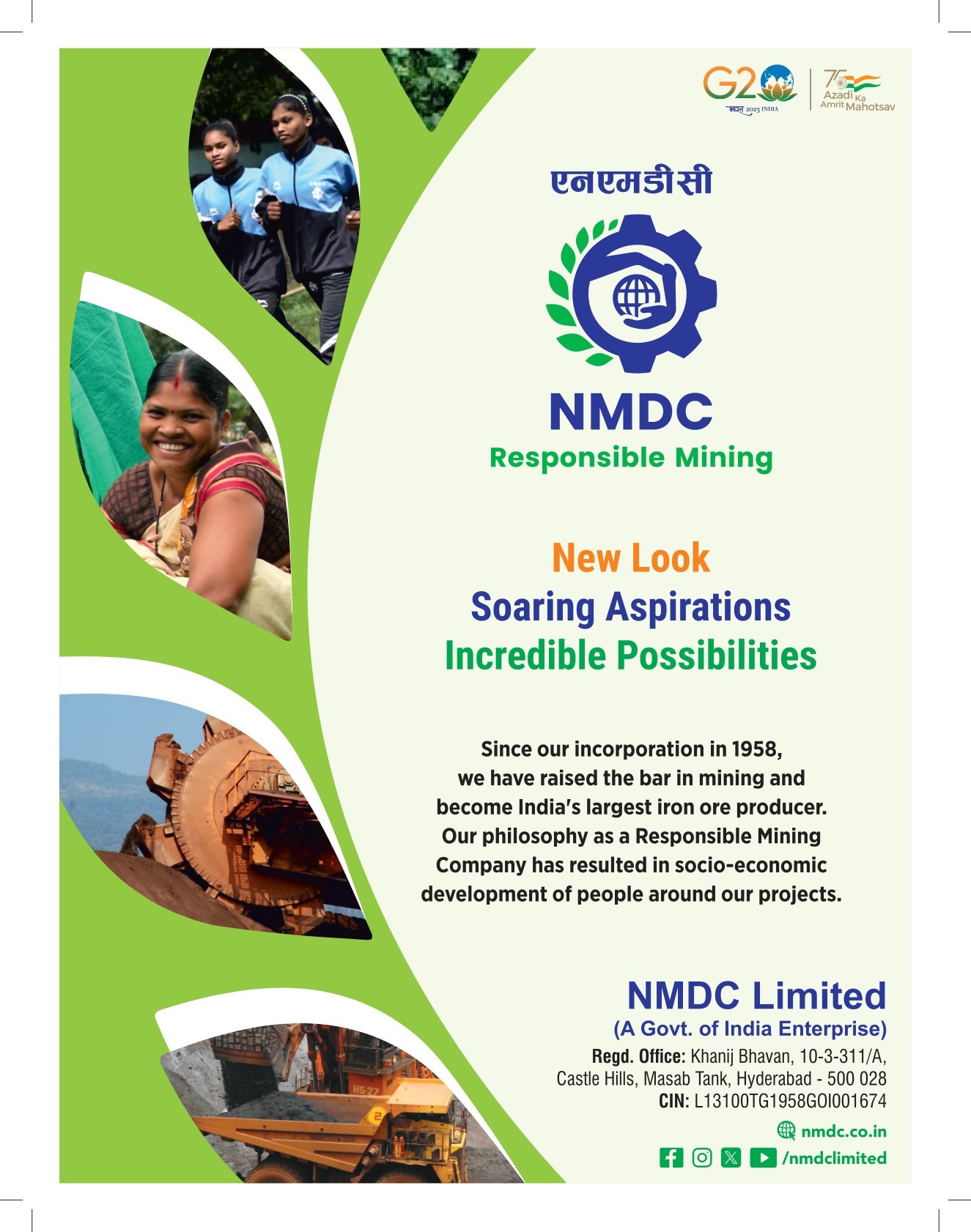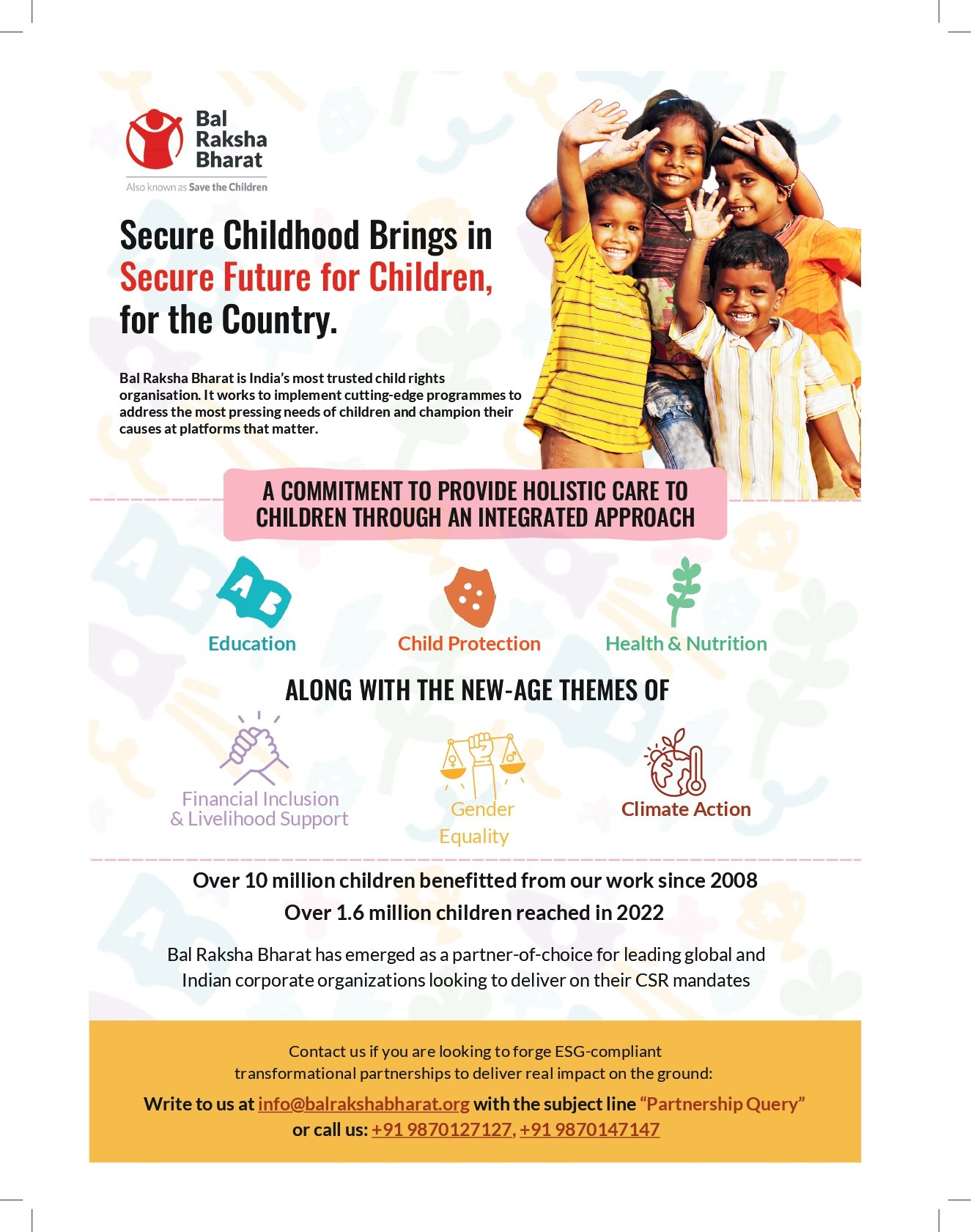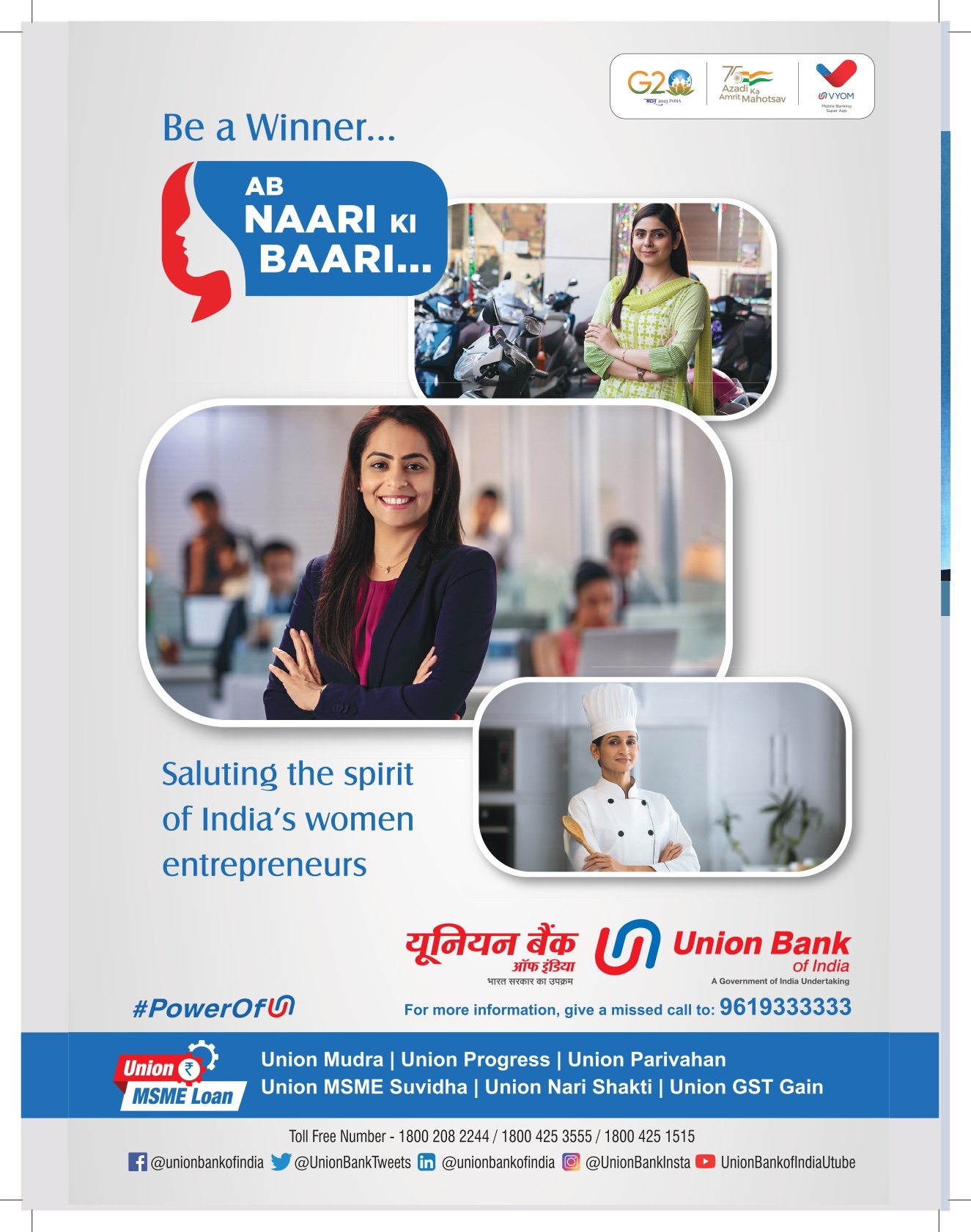COVER STORY

TECH MAHINDRA FOUNDATION: Empowering through Education
Tech Mahindra Foundation works in 12 cities, has 100 smart centres, and 67 education and disability projects. It has three academies and the Tech Mahindra School of Nursing at Banasthali too. It has partnership with six municipal corporations and aims to reach out to 50,000 direct beneficiaries in 2017-18.
Anand Mahindra has been quoted as saying, “Education is the single most powerful intervention for transforming lives.” India is a young country compared to many developed nations. The median age is 29 years, and the majority of the population is below the age of 35. There has been a lot of buzz around India’s ‘demographic dividend’ waiting to be tapped, and an equal amount of concern about the same young people whose progress in life might be obstructed by a lack of access to education and skills at the right time. Set up in 2007, with the mission of “Empowering through Education”, Tech Mahindra Foundation has been at work on CSR much before it was made mandatory. Through its efforts, the Foundation hopes that India’s ‘demographic dividend’ pays off. When the Foundation initially started its work, it focused chiefly on improving school education through its NGO partners. Over the years, the team felt the need to continue their intervention along the spectrum of education, beyond primary school. “What happens to those who fall through the cracks and dropout in Class VII or VIII? Where does that child who has not been able to finish his or her studies work?” asks Loveleen Kacker, the CEO of Tech Mahindra Foundation. “In 2012, when I came onboard, we quickly realized that education was not enough to get someone a job. Employability is the key.” And so the Foundation’s flagship employability vertical came into the picture.
A SMART Solution
Skills for Market Training (SMART) is an employability programme of Tech Mahindra. While skilling has taken centre stage under the current government, the SMART programme was launched prior to the Skill India mission. In 2012- 13, Tech Mahindra Foundation began three centres providing job skills for young people. The curriculum included English, computer skills, and crucially, coached them in ‘workplace readiness’ so that the SMART trainees could walk into a new job prepared for what would be expected of them. Initially, retail and hospitality were the main sectors for which young people were trained. The start was deliberately slow. Chetan Kapoor, the Chief Operating Officer of Tech Mahindra Foundation, says, “We built quality into the DNA of the SMART programme. It is very difficult to retrofit quality standards after scaling up. The initial growth of the programme was deliberately set at a certain pace so that our processes and monitoring were robust. We have invested a lot of time and effort into building capacity of our NGO partners and the training of trainers. There is a fixed curriculum, and we are confident in the quality of training provided across the country.”
As Kapoor points out, Tech Mahindra Foundation is a very hands-on CSR partner. Support goes much further than finances. In the initial stages of SMART, standard operating procedures (SOPs) were put into place for the entire programme, starting from selecting NGO partners, to the admission procedures for the young people in need of jobs. Capacity building of the partners and making sure that they follow the SOPs have been key elements in this process. In just five years, the SMART programme has scaled up from three centres to 100 centres in 11 cities. The Foundation has provided employability skills to 50,000 young people so far, and is targeting reaching another 20,000 in 2017-18. In 2015, KPMG carried out an audit of the SMART programme. One of the key revelations of the study was the fact that KPMG not only vouched for SMART’s 70 per cent annual placement rate, but also assessed the Social Return on Investment (SROI) of the programme at Rs 13.29 for every rupee invested. From the initial focus on retail and hospitality, the bouquet of courses offered has gradually been diversified. SMART-T is the technical training programme with longer duration courses such as air-conditioning and refrigeration maintenance, CNC machine operation, Tally, beauty and wellness and more.
Tech Mahindra Foundation’s own mandate states that 50 per cent of all beneficiaries must be girls and young women, and 10 per cent persons with disabilities. SMART+ is their skilling programme for persons with disabilities. Many of their SMART+ trainees work in hospitality with conscientious employers willing to promote inclusivity, such as the Lemon Tree hotels and Le Meridien hiring from them. Their hundredth SMART centre, which was recently inaugurated in Mumbai is a bold step for SMART+ as they plan to provide technical training like plumbing and maintenance to persons with disabilities. Run – in partnership with the Helen Keller Institute for the Deaf- Blind, the Foundation hopes that this SMART+ centre will become a model that can be replicated.
Creating Ac ademies
Buoyed by the success of its SMART programme, in May 2016, the Foundation inaugurated the very first Tech Mahindra SMART Academy for Healthcare at the Gandhi Ashram, New Delhi. The Academy is directly managed by the Foundation, without an NGO implementing partner. A visit to the Academy is something quite special. A little beyond the noise and chaos of the GTB Nagar metro station near Delhi University lies the Gandhi Ashram. Few people know that Mahatma Gandhi himself had established an ashram in Delhi, and fewer still that the purpose of this Ashram was to provide skills to marginalized youth. Gandhi had set up the Harijan Sevak Sangh in 1932 and the building in which the Academy operates, dates from 1936. It is hard to pinpoint what makes the campus so soothing…
What is your view on the CSR policy of the Companies Act 2013? Any changes you would like to see?
The Companies Act 2013 is a really welcome Act. Tech Mahindra has been carrying out its CSR work through the Foundation since 2007, well before the Act, and we are glad that more companies are getting into this space. One of the big benefits of the Act is that it has brought out the difference between charity and social development. It has also encouraged the creation of ‘shared value’. One-time charity like sponsoring a meal for children at an orphanage or a one off event has been separated from social development. What companies often did as mere chequebook or donation CSR has mandated into more meaningful sustainable social development.
Tech Mahindra’s CSR programmes started possibly a decade back, where have you reached to achieve your vision and mission? Where do you see yourself in terms of reaching out to the marginalised, the underprivileged, in the coming decade?
Our mission has been that of ‘Empowerment through Education’. The numbers speak for themselves—we’ve skilled 50,000 youth in the past five years through SMART, and the placement rate is over 70 per cent. This has a huge knock-on effect for the families of those young people who now have jobs. Tech Mahindra Foundation had got KPMG to assess SMART. Families of young girls are willing to let them work, and gain independence once they get trained. The psychological benefit of a programme like this is also huge; the confidence boost gained by improved language and soft skills goes a long way. School improvement is an area in which results take a long time to show, but an area where interventions are worthwhile in the end. We have touched thousands of school children through ARISE and ARISE+, and now Shikshaantar as well.
You are active in the Tech Mahindra Foundation and have also founded Titliyan, an NGO working for underprivileged children. What is your focus?
Education has since long been recognized as the surest way to empower a community. However, we define education with a broad stroke—it encompasses early childhood development as well as skill development of youth. Titliyan is my small personal contribution. We are helping shape the lives of a small group of about 200 children in Noida by providing them with good quality education.
What major steps should be taken to ensure every child and youth in India has access to quality education?
There is a need to think out of the box. One way could be intervention via technology. If policy-makers as well as other stakeholders like corporates start thinking of solutions that are now made feasible through innovation, this daunting task can be easily managed. With cost of hardware coming down and broadband connectivity becoming universal, technologies like AR/VR can revolutionise the way quality education is provided.
You had your education in a small industrial t own and must have come across people with great potential but limited resources and opportunities. What can companies like Tech Mahindra do to give a boost to those hidden talents?
India is full of people who have immense potential and ability to contribute to society in a far more meaningful way. Again, the role of technology should be explored here. For instance, broadband connectivity and ecommerce has opened immense opportunities to remote regions. The same can also be true in the space of Edutech. We are already seeing several start-ups in the space, indicating the intervention of the right technology. Considering the geographic spread and an unclear revenue model, the only way this technology will reach the rural hinterlands is either through NGOs supported by corporates or through policy enablement.
What would be your message to the underprivileged child and youth living in the remotest corner of the country aspiring to be a successful entrepreneur some day?
Technology and rapid innovation today is allowing the proliferation of facilities to every corner of the planet at accelerated pace year on year. The youth should focus on building a positive attitude towards socio-economic changes and work towards building specific skills that are in tune with their inherent talent. This will enable them to contribute in a meaningful way to their community and therein lays a huge opportunity. If you look around you, most of the fast growing start-ups are not only technology enabled, they are growing by dismantling an existing old-world system or by creating a completely new one.
You joined the Tech Mahindra Foundation just before the government’s new CSR policy came into force. What changes have been brought by you in the CSR programmes of the company since 2013?
I had a great advantage in the sense that I not only joined at the time when the CSR Act was coming but I also had the advantage of a comparatively clean slate with a large company, with a huge CSR spend. I had the opportunity to think de novo about what direction the Foundation should take. Earlier the Foundation had largely been in education but slowly we realised that it was time to go into skilling. While we retained the thought of original education and disability, the main vertical that we added at that time was skilling. The enactment of the CSR Act was a happy coincidence, because I had the advantage of a rise in CSR spending.
We understand Tech Mahindra works on three key areas—education, employability and disability. What is the focus—primary education, higher education or skill-based education?
Skilling remains our primary focus with almost 70 per cent of all our funding and efforts going into skilling. We also talk about a continuum of education. Let’s not forget that skilling too is a form of education. When we say primary education and skilling, do keep in mind that the young people who we are training in trades have also undergone some form of education. It is just that this specific education is aimed at making them more professional workers.
How do you identify possible implementing partners and what steps do you take to keep an eye on proper execution of the programmes?
We have a stringently laid down process for partner selection. There are a series of boxes that you need to tick. Among them of course are the legal requirements, like the organization should have been in existence for at least three years and should have the relevant experience in the area in which they ask for funding. But we go much beyond that—we go into the capacities of the organisation, their ability to implement. We talk to the kids they work with, their communities and it is not that difficult to find out whether or not an organisation is actually making an impact. Our monitoring process is one of our major achievements. I’m proud of our system of keeping track not only of the funds spent but also of the targets achieved. So we are able to do that through constant physical monitoring as well as audits. More than this, we are able to collect huge amounts of qualitative data, which can be analysed at the headquarters to assess not just whether money is being spent appropriately, but whether it is being spent well and if the thought that we have behind the programme is actually being achieved. Quality for us is a very important factor.
You have several CSR programmes across the country. What major impact have you been able to make in the lives of people?
Impact can be assessed in a couple of different ways. One way of course is by sheer numbers. In the current year, 2017- 18, the Foundation will directly impact the lives of roughly 50,000 children and young people across our three verticals. However, the larger impact, when you look at the lives indirectly touched by this would be close to 2 lakh. In terms of fund utilisation impact, we are using 100% of the funds allocated and following government rules. However, I think, the more important way in which any impact should actually be assessed is in the quality of the work that is imparted. And in this we have really very stringent processes. For us, it is not very important to keep on adding numbers and centres and students and more important to see that when we reach someone, we actually make an impact in that person’s life.
How do you think can a strong network be build between the government, private companies and civil society for the progress of the needy?
Government and civil society in my opinion have always been at loggerheads. This is actually nothing new. The reason for this is normally the government’s policy making processes are quite cumbersome and changes don’t come so easily. Civil society, specially the activists among civil society are able to foresee possible change and the way things are moving and press for them. The need for civil society and activists in any democracy always remains paramount. They are able to hold a mirror to government and show which policies are taking you back and not forward. The corporate are in an in-between position normally. We are not really the activists, we don’t take to the streets in that sense and neither are we the government or bureaucracy. But most of us are also invited to think tanks and committees that shape policies or implement them.
Very often when the numbers and scale in the government are very large, it becomes difficult to look for success stories and impact. Corporates are able to show the government that there is a different way for things to be done, there are other methods. I would say that the government, corporates and civil society, all three, have an important role to play.
whether it is the aura of the great man which still lingers or the pleasant shock of finding a tranquil green area just beyond a very crowded, disorganized street. Inside the old walls of the Academy though lies a thoroughly modern medical training centre — complete with a state-of-the-art training ambulance, mock operating theatre lab, dialysis lab, X-ray lab and basic skills labs. Loveleen Kacker, says, “India has a dire need for allied health care professionals and our youth are looking for meaningful jobs. A government report estimated a shortage of a whopping 64 lakh health professionals. The Academy aims at giving top-notch health skills to young people through its state-of-the-art labs.” In the first year, the Academy ran courses to train general duty assistants, emergency medical technicians and operation theatre technicians. In its second year, it has started training dialysis technicians, hospital front office and billing executives and will soon launch courses to certify X-ray technicians as well. The coming months will also see the launch of the second Tech Mahindra SMART Academy for Healthcare, in Mohali, Chandigarh and the Tech Mahindra SMART Academy for IT & Logistics in Visakhapatnam.
The Road Ahead
The Foundation is now aiming to build links along what Kacker refers to as “the continuum of education.” As she points out, someone in their skilling programme has already been subjected to an educational programme to a certain extent. Providing employable skills is the final step of the education process. Tech Mahindra Foundation supports several schools through its All Round Improvement in School Education (ARISE) and All Round Improvement in Special Education (ARISE+). Shikshaantar is another education programme run by Tech Mahindra Foundation which works to build capacity for educators i.e. teachers, school principals and even school inspectors. The In-Service Teacher Education Institute is a public-private partnership between the Foundation and the East Delhi Municipal Corporation. The Foundation currently has six partnerships with different municipal corporations in India. Tech Mahindra Foundation celebrated the dual milestones of completing ten years and inaugurating its 100th SMART Centre in April 2017. As Kacker wrote on the occasion, “The road so far has neither been easy nor perfect. Through all these years, what has ensured that we persisted, even when we worried about the impact we were making, there has been the unstinting support the Tech Mahindra family has shown us. We now have a decade of learning and growth behind us, and are earning the trust of the communities we work with. We are quietly confident about taking on challenges of the next 10 years.” She adds, “As the world progresses, it is all the more urgent that India’s young people at the bottom of the pyramid are not left out as in the past. We know that our work touches a fraction of the total number of people who need interventions like SMART to be able to take charge of their lives.” She affirms though that every small step makes a difference. As the Foundation’s own reports, and KPMG’s assessment show, when the most vulnerable in society are empowered, everybody benefits.



































